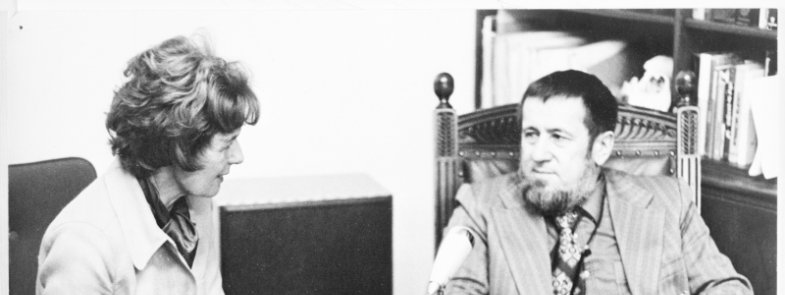
Largely regarded as Australia’s first oral historian, Hazel de Berg recorded interviews with 1,290 Australians who were born between 1865 and 1953. Without her work, many of these people would never have their voices recorded for us to listen to today.
Hazel interviewed very widely but artists were particularly well-represented – she recorded around 250 painters and sculptors. But she also interviewed individuals as diverse as Don Banks (composer), J. H. Carver (physicist), Harry Seidler (architect), Robert Helpmann (dancer), Jack Lang (politician), Jessie Street (feminist), Peter Weir (film director) and Bruce Williams (economist) to name just a few!
The National Portrait Gallery recently partnered with the National Library to bring to life, In their own words. This new National Portrait Gallery exhibition lets the Gallery’s portraits of remarkable Australians speak for themselves. An audio-guide with a difference, it features two-minute stories told by select subjects and artists from the collection, using Hazel de Berg’s extraordinary audio recordings of Australian achievers – held in the National Library of Australia’s Oral History and Folklore Collection.
Read Senior Curator Oral History and Indigenous Programs, Dr Shirleene Robinsons' blog.
Find out more about the National Portrait Gallery In their own words exhibition.
Listen online to some of Hazel de Berg's interviews featured in the exhibition
For some of Hazel de Berg's interviews you will need a digital login to request them. To get your digital login, join the Library.
Appleton speaks of her life and studies at the East Sydney Technical College and Westminster School, London; her interest in sculpture; method of painting.
Bass speaks about his early years; the Depression years; his beginnings as a sculptor; selecting the right art school; studying under Wadswell; his first commission; his philosophy of sculpture; his method of working; his thoughts about Canberra.
Boyd speaks about the artistic environment in which he grew up; the influence of religion on his work; method of painting and direction of his painting.
Drysdale speaks of his reasons for painting; method of painting; the subjects of his paintings.
Dupain speaks of his childhood in Ashfield, N.S.W.; his early training as a photographer; joining the Air Force during World War II and working in the camouflage program; returning to his studies after the war; equipment used for his photographic work; the importance of exhibitions.
Dame Mary Gilmore reads excerpts from her writings; she also speaks about Australia and the May Day Literary award.
Hazel de Berg speaks about Dame Mary Gilmore in this oral history, when being interviewed on the radio program "News Magazine".
Grundy describes his family and childhood in Sydney; he speaks of the difficulties encountered when trying to get into show business; the Grundy Organisation; he gives his views on the film industry in Australia and speaks of his fascination for the electronic era.
Lindsay speaks of the lack of national pride in Australian art; perceived divisions in the world today; problems facing the new generation; J.F. Archibald and Julian Ashton's contribution to art in Australia; his views on the atomic bomb.
McCullough speaks of her schooling and of her relationship with her father; working in the field of neurophysiology in the U.K. and the U.S.; working on her novels "Tim" and "The thorn birds"; promoting her novels in the U.S.; her method of work; she discusses the characters in the Thorn birds.
Olley speaks about her early interest in art; her stay in Europe; her method of painting.
Proctor speaks of the Impressionists; Australian art in the 1920's; art studies; George Lambert's painting method; her painting method.
Williamson speaks of his family background; his academic performance in high school; reasons for studying engineering; teaching engineering for 7 years; writing his first plays; the problems in having "Don's party" accepted by theatre groups; the beginnings of his career as a playwright with the production of "The removalists"; he speaks of his method of work when drafting a play.
John Bell speaks of his art studies at the Sydney Technical College; influences on his painting; feelings about painting.
Humphries describes his years as a student in Melbourne; his attraction to the modern school of painting; the Dadaist movement and other surealist painters; studying painting under George Bell; his disapointments while at Melbourne University; his theatrical debut in the early 1950s.
Keneally speaks of his childhood; his novel "The fear"; his studies; the element of catholicism in his life; entering the seminary (1953); his experience in the Public Service; teaching; his obsession with mortality; meeting his future wife; the state of Australian drama; his method of work.
Olsen speaks of his background; studies and influences; routine and method in painting.
Learn more about the Library's Oral History collection
- Find out more about Hazel de Berg and her oral history collection.
- Find out more about how you can use the National Library’s Oral History and Folklore Collection.
- Find out more about other Oral History Collections we hold at the Library.